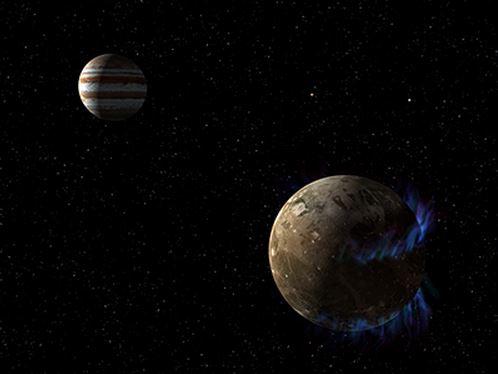Ganymede is Jupiter’s largest moon, and also the biggest moon in our solar system. NASA’s Hubble Space Telescope has provided compelling evidence of an underground saltwater ocean on Ganymede with more water than there is on Earth.
Scientists searching for habitable world’s beyond Earth say that liquid water is a crucial component. For other planets to have life as we know it, they must have water.
John Grunsfeld, assistant administrator of NASA’s Science Mission Directorate at NASA Headquarters, Washington, D.C., said:
“This discovery marks a significant milestone, highlighting what only Hubble can accomplish. In its 25 years in orbit, Hubble has made many scientific discoveries in our own solar system. A deep ocean under the icy crust of Ganymede opens up further exciting possibilities for life beyond Earth.”

An illustration of the interior of Ganymede. The cake-layering of the moon shows that ices and a saline ocean dominate the outer layers. A denser rock mantle lies deeper in the moon, and finally an iron core beneath that. (Image: hubblesite.org)
The scientists, from from Germany, the US, and Sweden, have published their findings in the Journal of Geophysical Research: Space Physics (citation below), March 12th issue.
Ganymede is the only moon in our solar system with its own magnetic field. The magnetic field causes aurorae, which are ribbons of glowing, hot electrified gas in its polar regions.
Ganymede is also embedded in Jupiter’s magnetic field. Ganymede’s aurorae change, “rocking” back and forth, as Jupiter’s magnetic field alters.
Observing aurorae led to saltwater suspicion
By observing the rocking movements of the two aurorae, astrophysicists were able to determine that Ganymede’s crust had a large about of saltwater, affecting its magnetic field.
Joachim Saur, professor at the Institute for Geophysics and Meteorology of the University of Cologne in Germany, and colleagues decided to use the Hubble Space Telescope to learn more about the inside of Ganymede.
Prof. Saur said:
“I was always brainstorming how we could use a telescope in other ways. Is there a way you could use a telescope to look inside a planetary body?”
“Then I thought, the aurorae! Because aurorae are controlled by the magnetic field, if you observe the aurorae in an appropriate way, you learn something about the magnetic field. If you know the magnetic field, then you know something about the moon’s interior.”

An artist’s concept of Ganymede as it orbits Jupiter. NASA’s Hubble Space Telescope observed aurorae on the moon that are controlled by Ganymede’s magnetic fields. Two auroral ovals can be seen over northern and southern mid-latitudes. (Image: hubblesite.org)
If Ganymede did have a saltwater ocean, Jupiter’s magnetic field would create a secondary one in the ocean that would counter Jupiter’s field.
This ‘magnetic friction’ would reduce the rocking of the aurorae. “This ocean fights Jupiter’s magnetic field so strongly that it reduces the rocking of the aurorae to 2 degrees, instead of 6 degrees if the ocean were not present,” the researchers wrote.
A massive ocean under a thick crust of ice
The research team estimates that the ocean is 100 kilometers (60 miles) thick – making it ten times deeper than oceans on Earth – and lies beneath a crust of (mostly) ice 150 kilometers (95 miles) thick.
Astronomers first suspected that Ganymede had an ocean forty years ago, based on models of the large moon.
In 2002, NASA’s Galileo mission measured Ganymede’s magnetic field, which provided the first evidence of a possible ocean.
The Galileo spacecraft took several ‘snapshot’ measurements of the moon’s magnetic field in 20-minute intervals. However, “its observations were too brief to distinctly catch the cyclical rocking of the ocean’s secondary magnetic field,” the scientists explained.
The latest observations were done in ultraviolet light, something that can only be accomplished using a space telescope outside Earth’s atmosphere (atmosphere blocks out most ultraviolet light).
Citation: “The search for a subsurface ocean in Ganymede with Hubble Space Telescope observations of its auroral ovals,” Joachim Saur, Stefan Duling, Lorenz Roth, Xianzhe Jia, Darrell F. Strobel, Paul D. Feldman, Ulrich R. Christensen, Kurt D. Retherford, Melissa A. McGrath, Fabrizio Musacchio, Alexandre Wennmacher, Fritz M. Neubauer, Sven Simon andOliver Hartkorn. Journal of Geophysical Research: Space Physics. Article first published online 12 March, 2015. DOI: 10.1002/2014JA020778.
